
The Democratic People's Republic of Korea (DPRK) has been developing nuclear-capable submarine-launched ballistic missiles (SLBMs) and ballistic missile submarines. While numerous articles about the test launch activities and the ballistic missile submarines exist, there appears to be a lack of discussion on how the DPRK leadership might deploy their sea-based strategic assets. This report tries to initiate such a discussion and, through an analysis of the geographical and technological constraints associated with the DPRK's submarines, to forecast the operation mode of the State's future ballistic missile submarine fleet.
Geographical Constraints
The Korean People's Army (KPA) navy has roughly 20 Chinese Type 033 medium-size submarines [1] and around 40 to 50 small and midget submarines. [2] These submarines operate in the West Sea (part of the Yellow Sea) and the Korean East Sea (Sea of Japan). [3] The West Sea is a confined space of shallow water. The Korean East Sea is a large body of water that is more suitable for the operation of relatively large submarines, such as the Type 033.
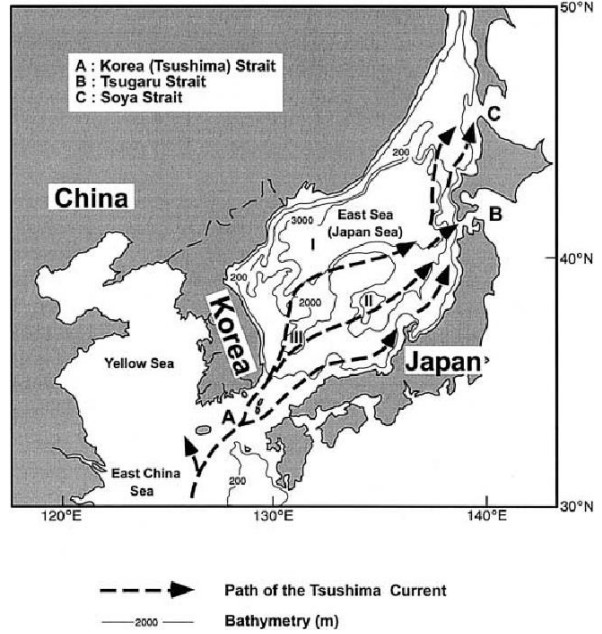
Figure 1. Passages from the Korean East Sea to the Pacific are marked by A, B and C. Image: S.-C. Park, Dong-Geun Yoo [4]
Venturing into the West Pacific from the Korean East Sea will be risky for the submarines of the KPA navy because the only passages to the Pacific, namely the Soya Strait, the Tsugaru Strait and the Tsushima Strait (Figure 1), are choke points outside its sphere of influence and are controlled by advanced adversarial anti-submarine warfare (ASW) forces. [5]
Additionally, the division on the Korean Peninsula makes it difficult for the KPA navy vessels in the West Sea and those in the Korean East Sea to support each other's operations. These geographical constraints are reflected in the distribution of the KPA navy's Type 033 submarines. The Pip'a-got submarine base on the west coast of the DPRK accommodates only three Type 033 submarines (Figure 2).
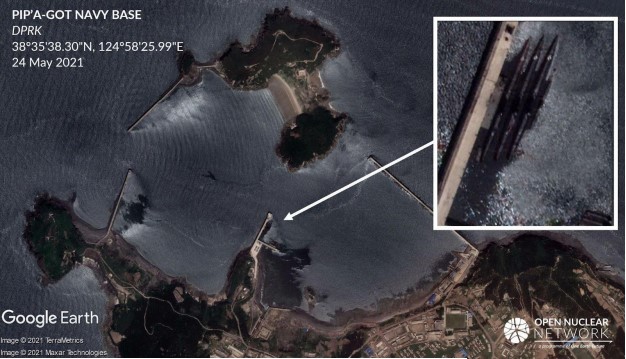
Figure 2. The Pip'a-got navy base hosts three Type-033 submarines. Image: Google Earth
The Cha'ho navy base and the Mayang-do navy bases (including the adjacent Sinpo South Shipyard) on the east coast together host 18 Type 033 submarines. (Figure 3).
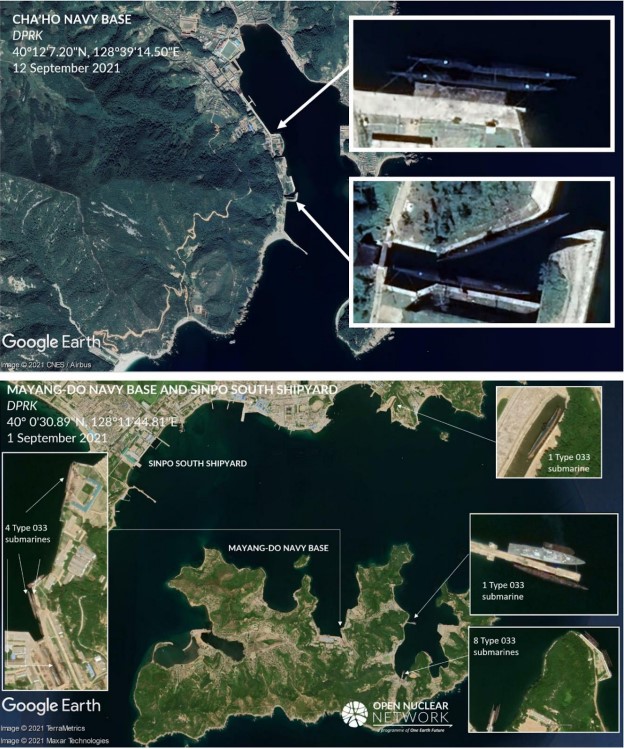
Figure 3. A total of 18 Type 033 submarines are visible at Cha'ho navy base (top) and Mayang-do navy base in satellite images taken in September 2021. Images: Google Earth
On the basis of the information above, it is reasonable to assume that the Korean East Sea will continue to be the main operational theatre of the relatively large submarines of the KPA navy, including those armed with SLBMs.
Technological Constraints
The DPRK is known to have built one ballistic missile submarine, the 8.24 Yongung [8.24 영웅함], [6] which is a small testbed with only one launch tube for a single SLBM. In order to form an operational submarine fleet, the DPRK would need to build more capable ballistic missile submarines. In July 2019, DPRK leader Kim Jong Un inspected a Type 033 submarine that was apparently undergoing conversion to a ballistic missile submarine at the Sinpo South Shipyard (Figure 4). [7]

Figure 4. Left: 8.24 Yongung submarine. Right: Type 033 submarine, thought to be in the process of conversion to a ballistic missile submarine. Images: KCTV
However, the Type 033 submarines - the largest in the KPA navy - use technologies from the late 1950s. By modern standards, they are vulnerable to advanced anti-submarine warfare (ASW) capabilities due to their high noise level and the relatively short time they can remain submerged. The fact that the first relatively large ballistic submarine of the DPRK is being converted from an obsolete Type 033 hull indicates that the DPRK is not yet ready to build a new submarine with significant improvement in performance over a Type 033 hull.
Advanced ASW capabilities of Japan, the Republic of Korea (ROK) and the USA are highly concentrated in the Korean East Sea. These countries have deployed state-of-the-art submarines, frigates, destroyers and ASW aircraft. In particular, in order to defend itself and support the US fleet in the region, the Japan Maritime Self-Defense Force has been focusing on ASW capabilities as a basic force building concept. [8] The inferior DPRK submarine forces will remain unable to match these advanced ASW capabilities for the foreseeable future.
Deployment Outlook
Deployment in Korean East Sea
Given these geographical and technological constraints, and considering the state of development of the DPRK's SLBMs, two possible operational modes could be adopted for the KPA navy's ballistic missile submarines in the Korean East Sea: littoral and offshore deployment.
Littoral Deployment
In this operation mode, the ballistic missile submarines would operate close to the DPRK coastline in order to gain the following advantages:
-
The submarines could operate under the cover of land-based surface-to-air missiles, fighter jets and navy vessels such as corvettes and sub-chasers. The cover would be neither comprehensive nor effective, as these defensive weapon systems are also relatively obsolete and could be quickly suppressed or destroyed by enemy forces. However, the cover by supporting forces could be expected to buy more time for the submarine crew to launch the SLBMs.
-
The submarines could also leverage the prevalent ambient noise [10] and the complicated environment [11] such as variable salinity and thermal zones [12] of the shallow waters to better hide from enemy ASW forces.
-
Littoral deployment mode could facilitate the operation of submarines with little displacement and low endurance.
-
The submarines and crews would have a better chance of surviving an accident or emergency, owing to the proximity to shore.
-
Littoral deployment is less challenging for command and control than offshore deployment.
Such deployment is similar to that of the "strategic bastion" - a patrol area northeast of the Kola Peninsula - where Soviet strategic submarines operated under the escort and protection of friendly forces during the Cold War. [13] In the case of the DPRK, the first SLBM developed by the DPRK, the Pukguksong-1, would be able to reach major countervalue targets beyond the ROK (Tokyo, Beijing and Shanghai) if fired from the littoral waters in the Korean East Sea (Figure 5).

Figure 5. Launched from waters near the Mayang-do navy base, a Pukguksong-1 SLBM with an estimated range of around 1200 km [9] could cover all major counter-value targets in the region. Image: Google Earth
Offshore Deployment
On 19 October 2021, the DPRK tested a short-range SLBM from waters near the Sinpo South Shipyard. The missile flew roughly 600 km before landing in the Korean East Sea. [14] This flight distance would just cover most of the ROK from the east coast of the DPRK, and would reach only a limited number of targets beyond the ROK (Figure 6).
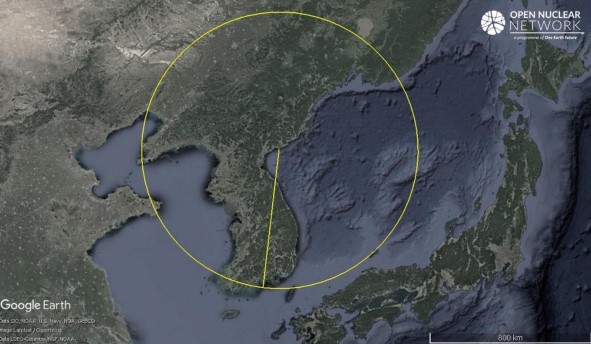
Figure 6. A 600 km range SLBM launched from waters close to Mayang-do navy base could cover most of the ROK. Image: Google Earth
The test firing of a single-stage, short-range SLBM after the apparently successful test-fires of two-stage, mid-range SLBMs is a curious development. Most of the nuclear-weapon-capable States started with the development of short- or mid-range SLBMs before those of intercontinental range.
The appearance of a short-range SLBM indicates that (1) the DPRK might wish to have a dedicated short-range SLBM to target only the ROK and to use mid-range SLBMs for regional targets beyond the ROK, or (2) alternatively, the DPRK might be considering offshore deployment of its ballistic missile submarines deep within the Korean East Sea, so that a short-range SLBM could cover major targets in both the ROK and Japan. In either case, the small size of a short-range SLBM might enable a submarine to carry more missiles or make the construction of a ballistic missile submarine relatively easier.
The vast Korean East Sea could, in theory, become an operational theatre for DPRK submarines. However, considering the technological gap between the DPRK's submarines and the adversarial ASW capabilities referred to above, such deployment could be far riskier there than in littoral waters. For such a mission to succeed, the submarines would have to defeat the enemy ASW forces largely unaided. On the basis of available information, it is reasonable to assume that the DPRK still lacks the capabilities to construct a submarine with low noise level and long submerged endurance.
Potential of West Sea
As noted above, traditionally, the West Sea (part of the Yellow Sea) has not been the main operational theatre for Type 033 submarines. Also, its confined space would limit the operation of ballistic missile submarines of larger displacement.
However, in comparison to the high concentration of advanced ASW capabilities of adversaries in the Korean East Sea, the West Sea, and especially Korea Bay, could potentially provide a much safer environment for SLBM launch platforms thanks to its proximity to the Bohai Bay (Figure 7), which is closely guarded by the Chinese armed forces. [16] Thus, in times of tension or an armed conflict, the operation of ASW assets of the USA, the ROK or Japan could be obstructed by the naval and aviation forces of China's People's Liberation Army (PLA).
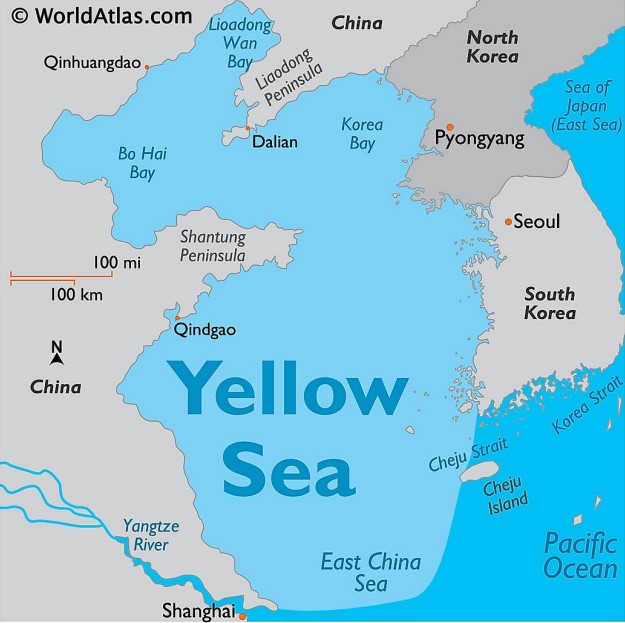
Figure 7. Dalian and Qingdao are two main bases of the North Sea Fleet of the PLA navy. [17] Image: World Atlas [15]
If the DPRK leadership assesses that China would not allow ASW operations of the USA and its allied forces on its doorstep, it might consider deploying ballistic missile submarines or unconventional SLBM launch platforms tailored to the confined waters of the Korea Bay, such as submersible barges equipped with SLBM launch tubes (Figure 8). [19]
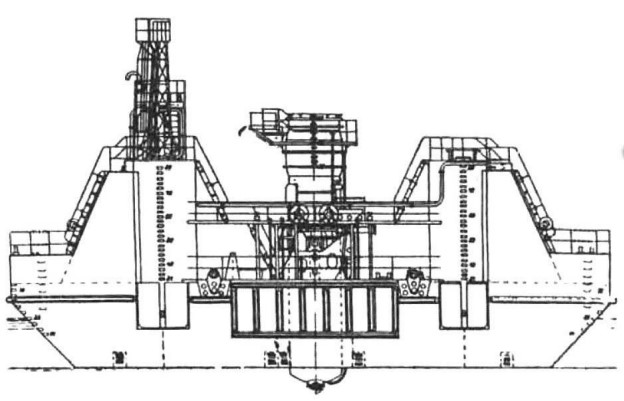
Figure 8. Line drawing of a Soviet submersible SLBM test barge. [20] Image: mil.in.ua1 [18]
Challenges Ahead
As described in the previous sections, littoral deployment in the Korean East Sea appears to be the best choice for the DPRK's future ballistic missile submarine fleet. However, for such a relatively safe deployment mode to work, the DPRK would have to address the following challenges:
-
Available information suggests that the DPRK has not finished the conversion of one of its Type 033 submarines to a ballistic missile submarine. This indicates that the conversion might have encountered problems or that the submarine's performance did not meet expectations.
-
To form an operational ballistic missile submarine force, the DPRK may need to convert more Type 033 submarines to ballistic missile submarines, or build new ballistic missile submarines, including nuclear-powered ones, on its own. [21]
-
The DPRK would need to keep a well-maintained strategic submarine fleet, well-trained crews and supporting forces tasked with safeguarding its littoral "strategic bastion".
[1] An Ye, 中国江南造船厂援外军事项目回顾 [Reviewing military assistance of the Jiangnan Shipyard], Naval & Merchant Ships, 2006, available at: http://mil.news.sina.com.cn/p/2006-01-23/0725346203.html. The Chinese Type 033 is a copy of the Soviet Romeo class submarine, which is a successor to the inferior Whisky class submarine. The DPRK imported four Whisky class submarines in the 1960s, and at least one is still in service in the Korean East Sea, according to some sources. See: Stijn Mitzer, Joost Oliemans, The Armed Forces of North Korea: On the Path of Songun, p187, Helion & Company, Warwick, 2020. However, official sources have considered all the Whisky class submarines to be retired. See: 2021 Defense of Japan, Ministry of Defense, Japan, available at: https://www.mod.go.jp/en/publ/w_paper/index.html; 2018 Defense White Paper, Ministry of National Defense, Republic of Korea, available at: https://www.mnd.go.kr/user/mndEN/upload/pblictn/PBLICTNEBOOK_201908070153390840.pdf
[2] 2021 Defense of Japan, Ministry of Defense, Japan, available at: https://www.mod.go.jp/en/publ/w_paper/index.html; 2018 Defense White Paper, Ministry of National Defense, Republic of Korea, available at: https://www.mnd.go.kr/user/mndEN/upload/pblictn/PBLICTNEBOOK_201908070153390840.pdf. Most notably, a midget submarine was alleged to have torpedoed the ROK naval ship Cheonan in 2010. See: Joint Investigation Report on the Attack Against the ROK Ship Cheonan, Ministry of National Defense, ROK, September 2021, available at: http://nautilus.org/wp-content/uploads/2012/01/Cheonan.pdf. However, small and midget submarines are beyond the scope of this article.
[3] The DPRK prefers to refer to the body of water between Japan and the Korean Peninsula as the "Korean East Sea". As this article discusses the future deployment of ballistic missile submarines by the DPRK, it uses that reference. See: 朴正天书记指导铁道机动导弹团检查射击训练 [Pak Jong Chon Guides Test Firing Drill of Railway-borne Missile Regiment], KCNA, 16 September 2021
[4] Park, SC., Yoo, DG., Lee, CW. et al, Last glacial sea-level changes and paleogeography of the Korea (Tsushima) Strait, Geo-Marine Letters, September 2000, available at: https://doi.org/10.1007/s003670000039
[5] As part of the US-Japan military alliance arrangement, the Japan Maritime Self-Defense Force was tasked with blocking these passages during the Cold War. See: Desmond Ball, Richard Tanter, The Tools of Owatatsumi: Japan's Ocean Surveillance and Coastal Defence Capabilities, p. 17, Australian National University Press, Canberra, 2015
[6] Academy of Defence Science Succeeds in Test-Launch of New Type SLBM, KCNA, 20 October 2021. The 8.24 Yongung is has been variously referred to as the Sinpo class, Sinpo-B class or Gorae class submarine.
[7] Supreme Leader Kim Jong Un Inspects Newly Built Submarine, KCNA, 23 July 2019. If adding this submarine, the number of Type 033 submarines would reach 22. However, it is possible that at least one Whisky class submarine was mistaken as a Type 033 submarine. From available satellite images, it is difficult to tell the difference between a Whisky class and a Type 033 under certain conditions. However, official sources have considered the Whisky class to be out of service. See: 2021 Defense of Japan, Ministry of Defense, Japan, available at: https://www.mod.go.jp/en/publ/w_paper/index.html; 2018 Defense White Paper, Ministry of National Defense, Republic of Korea, available at: https://www.mnd.go.kr/user/mndEN/upload/pblictn/PBLICTNEBOOK_201908070153390840.pdf
[8] Yoji Koda, Submarine Acquisition in Japan. In: Naval Modernisation in Southeast Asia, Part Two. Palgrave Macmillan, Cham, available at: https://doi.org/10.1007/978-3-319-58391-4_4
[9] David Wright, Range of the North Korean KN-11 Sub-Launched Missile, Union of Concerned Scientists, 30 August 2016, available at: https://allthingsnuclear.org/dwright/range-of-the-north-korean-kn-11-sub-launched-missile/
[10] Feng Jinchang, Li Wenjing, Mi Hongwei, 未来海域安全信息系统支持技术研究 [Research on supporting technologies for future sea territory information safety system], Hebei Science & Technology Press, Shijiazhuang, September 2020
[11] 浅海反潜战 [Anti-submarine warfare in shallow waters], Information Command Control System and Simulation Technology, 1st issue, 2002
[12] Hans J. Ohff, Nuclear versus diesel-electric: the case for conventional submarines for the RAN, Australian Strategic Policy Institute, 11 July 2017, available at: https://www.aspistrategist.org.au/nuclear-versus-diesel-electric-case-conventional-submarines-ran/
[13] Hans M. Kristensen, Russian Nuclear Submarine Patrols, Nuclear Brief, 3 August 2005, available at: https://www.nukestrat.com/russia/subpatrols.htm
[14] (7th LD) N. Korea fires what seems to be SLBM toward East Sea: S. Korea, Yonhap News Agency, 19 October 2021, available at: https://en.yna.co.kr/view/AEN20211019002958325?section=nk/nk
[15] Yellow Sea, World Atlas, available at: https://www.worldatlas.com/seas/yellow-sea.html
[16] The main task of the North Sea Fleet of the PLA navy is to defend the northern sea territory, with a focus on safeguarding the gateway to Beijing, China's capital. See: 守护京津海上门户的北海舰队 [The North Sea Fleet that safeguards the gateway on the sea to Beijing and Tianjin], China Pictorial, 6 July 2015, available at: http://www.chinapictorial.com.cn/ch/se/txt/2015-07/06/content_694824.htm
[17] 海军北海舰队发展史 创造人民海军诸多第一 [North Sea Fleet created many records in the history of the PLA navy], Qingdao Daily, 24 July 2017, available at: https://news.qingdaonews.com/wap/2017-07/24/content_12122910.htm
[18] Image available at: https://mil.in.ua/uk/articles/kndr-prodovzhuye-robotu-nad-zanuryuvalnym-stendom-scho-vykorystovuyetsya-dlya-testuvannya-puskiv-raket/
[19] Mobile submersible launch barges were studied as a low-cost and exotic basing mode before the Soviet Union decided to pursue the conventional submarine-basing mode for its sea-based intercontinental ballistic missiles. See: 俄罗斯海基战略导弹系统 [Russia’s sea-based strategic missile systems], p. 125, China Defense Science and Technology Information Center, 2017, Beijing
[20] The DPRK has two similar test barges. One is at the Sinpo South Shipyard on the east coast, the other at the Nampho shipyard on the west coast. See:Peter Makowsky, Nampho Naval Shipyard: Second Submersible Test Barge Still Out of Water, 38North, 29 July 2021, available at: https://www.38north.org/2021/07/nampho-naval-shipyard-second-submersible-test-barge-still-out-of-water/
[21] During the 8th Korean Workers' Party Congress in January 2021, Kim Jong Un stated that the design of a nuclear-powered submarine was in the final stage. He went on to imply that this submarine might be able to accommodate SLBMs with intercontinental range. See: On Report Made by Supreme Leader Kim Jong Un at Eighth Congress of WPK, KCNA, 9 January 2021